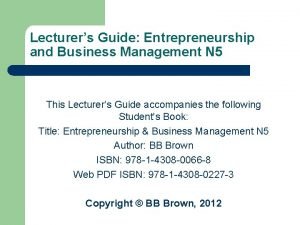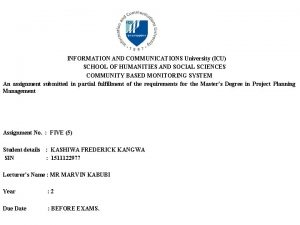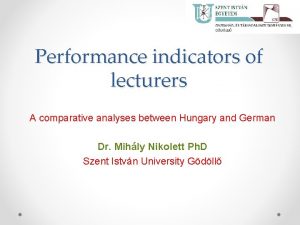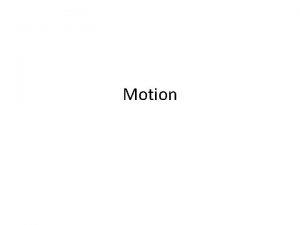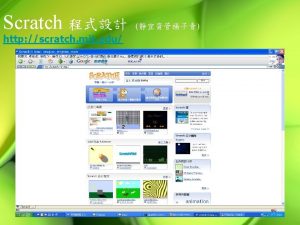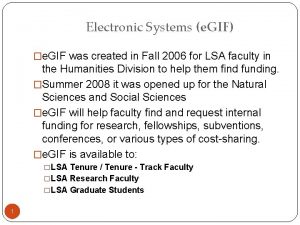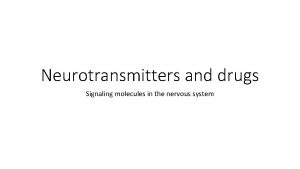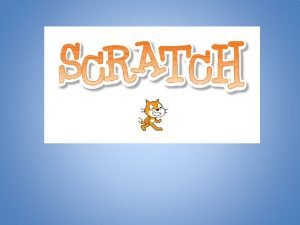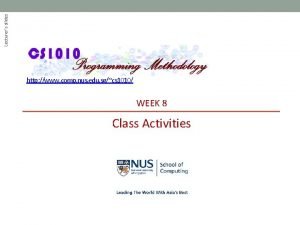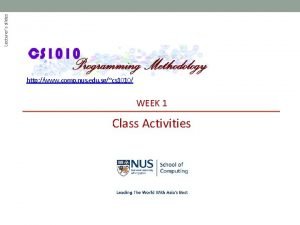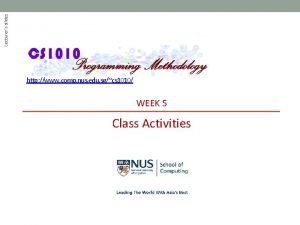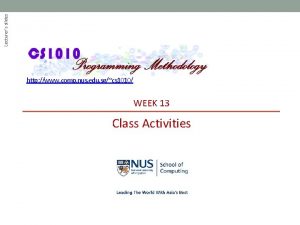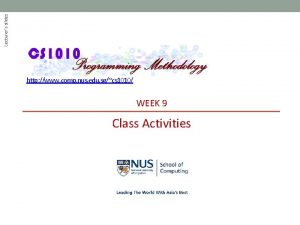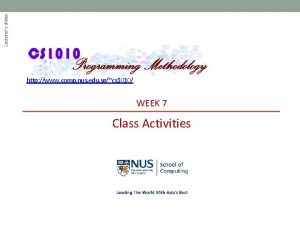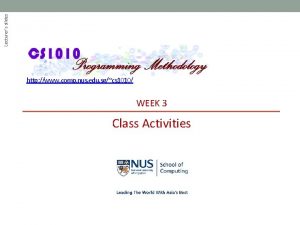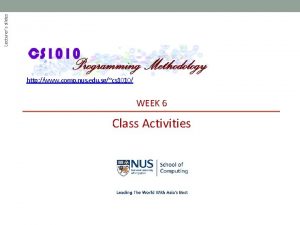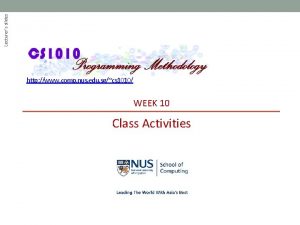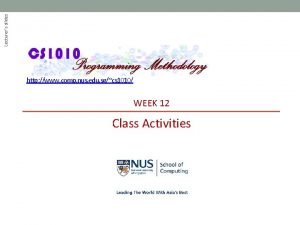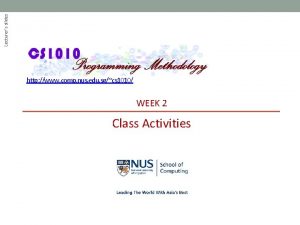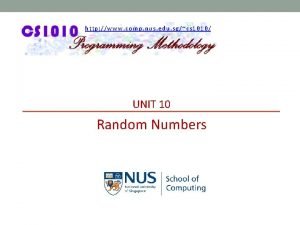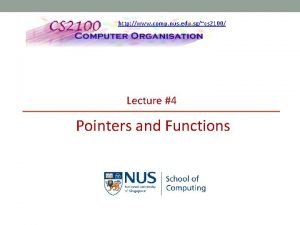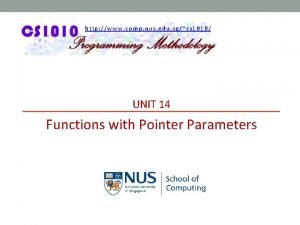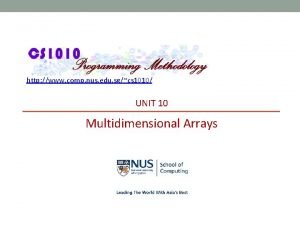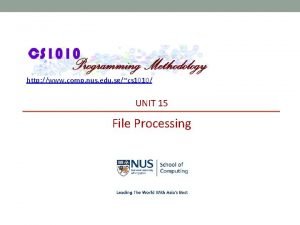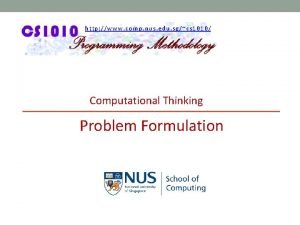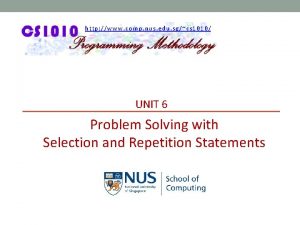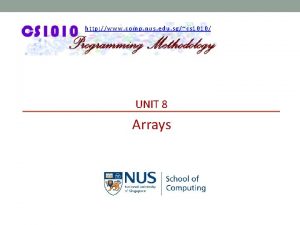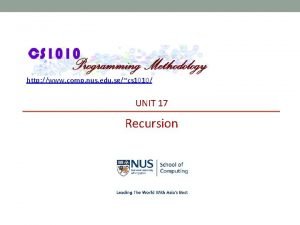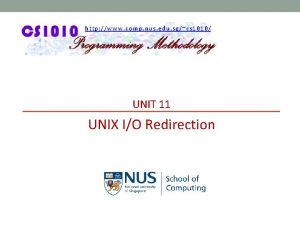Lecturers slides http www comp nus edu sgcs






















- Slides: 22

Lecturer’s slides http: //www. comp. nus. edu. sg/~cs 1010/ WEEK 4 Class Activities

© NUS CS 1010 (AY 2014/5 Semester 1) Week 4: Repetition Statements § Tracing while Loop § Tracing for Loop § Warm-up: List a Range of Integers § Exercise #1: Sum of Multiples of 3 § Exercise #2: Asterisks § Tracing Nested Loop § Exercise #3: Prime Number § Testing and Debugging (running theme) Week 4 - 2

© NUS CS 1010 (AY 2014/5 Semester 1) Week 4 - 3 Tracing while Loop (1/4) § Trace the following codes manually and write out their outputs (a) (b) int a = 1; while (a*a < 100) { printf("%d ", a); a *= 2; } printf("n"); 1 2 4 8 b=0, c=9 b=1, c=8 b=2, c=7 b=3, c=6 b=4, c=5 outside: b=5, c=4 int b = 0, c = 9; while (b < c) { printf("b=%d, c=%dn", b, c); b++; c--; } printf("outside: b=%d, c=%dn", b, c);

© NUS CS 1010 (AY 2014/5 Semester 1) Week 4 - 4 Tracing while Loop (2/4) § Example: Given a positive integer n, print out its digits from least significant to most significant. § Sample run: Enter a positive integer: 28943 3 4 9 8 2

© NUS CS 1010 (AY 2014/5 Semester 1) Week 4 - 5 Tracing while Loop (3/4) § Example: Given a positive integer n, print out its digits from least significant to most significant. Week 4_Print. Digits. c // Precond: n > 0 void print_digits(int n) int digit; { while (n > 0) { digit = n%10; printf("%dn", digit); n /= 10; } }

© NUS CS 1010 (AY 2014/5 Semester 1) Week 4 - 6 Tracing while Loop (4/4) Week 4_Print. Digits. c // Precond: n > 0 void print_digits(int n) int digit; { What are the values of n and digit after exiting the loop? while (n > 0) { digit = n%10; printf("%dn", digit); n /= 10; } } n initially 28943 n @ point 28943 2894 digit @ point *** 3 289 28 2 0 4 9 8 2

© NUS CS 1010 (AY 2014/5 Semester 1) Week 4 - 7 Tracing for Loop § Trace the following codes manually and write out their outputs (a) (b) int i, sum = 0; for (i=0; i <= 10; i+=2) { sum += i; } printf("sum = %dn", sum); sum = 30 i=1, sum=1 i=2, sum=3 i=4, sum=7 i=8, sum=15 i=16, sum=31 int i, sum = 0; Final i=32 for (i=1; sum < 20; i*=2) { Final sum=31 sum += i; printf("i=%d, sum=%dn", i, sum); } printf("Final i=%dn", i); printf("Final sum=%dn", sum);

© NUS CS 1010 (AY 2014/5 Semester 1) Week 4 - 8 Warm-up: List a Range of Integers (1/3) § Ask the user for 2 integers: a (the lower limit), and b (the upper limit), and print the list of integers from a to b. § Write a function list_integers(int lower, int upper) § Main function given: #include <stdio. h> void list_integers(int, int); int main(void) { int a, b; printf("Enter 2 integers a and b (a<=b): "); scanf("%d %d", &a, &b); list_integers(a, b); return 0; }

© NUS CS 1010 (AY 2014/5 Semester 1) Week 4 - 9 Warm-up: List a Range of Integers (2/3) § What should be the pre-condition of list_integer()? // List integers in the range [lower, upper] // Precond: lower <= upper void list_integers(int lower, int upper) { int num; . . . for (num=lower; num<=upper; num++) { printf("%d ", num); } printf("n"); } § Use a for loop to implement the function

© NUS CS 1010 (AY 2014/5 Semester 1) Week 4 - 10 Warm-up: List a Range of Integers (3/3) § Now, use a while loop to implement the function, without using any local variables // List integers in the range [lower, upper] // Precond: lower <= upper void list_integers(int lower, int upper) { while (lower <= upper) {. . . printf("%d ", lower); lower++; } printf("n"); }

© NUS CS 1010 (AY 2014/5 Semester 1) Week 4 - 11 Exercise #1: Sum of Multiples of 3 (1/2) § Modify the program Unit 6_Odd. Integers_v 1. c to read a positive integer n and then compute the sum of all integers which are multiples of 3 between 1 and n inclusive using a for loop. Write a function called sum_multiples_of_3(int). § This problem can be solved with a formula, but we will use the for loop just for exercise. § Call this program Sum. Multiples 3. c § Sample run: Enter a positive integer: 50 Sum = 408

© NUS CS 1010 (AY 2014/5 Semester 1) Week 4 - 12 Exercise #1: Sum of Multiples of 3 (2/2) § How about using a while loop instead? § Pseudo-code using a while loop: precondition: n > 0 sum 0 i n while (i > 0) if i is a multiple of 3 sum + i i i - 1 return sum

© NUS CS 1010 (AY 2014/5 Semester 1) Week 4 - 13 Exercise #2: Asterisks (1/2) § Write a program Asterisks. c to read an integer n and print a certain number of asterisks on a single line. Write a function print_asterisks(int). § If n is non-positive, then no asterisk should be printed. § Sample runs: Think! What is Enter n: 3 ***** Done! Enter n: 6 ****** Done! Enter n: 10 ********** Done! the relationship between n and the number of *? Enter n: -2 Done!

© NUS CS 1010 (AY 2014/5 Semester 1) Week 4 - 14 Exercise #2: Asterisks (2/2) § Write a program Asterisks. c to read an integer n and print a certain number of asterisks on a single line. Write a function print_asterisks(int). Pseudo-code: read input n; if n is non-positive print “Done!” and end program; m compute the number of asterisks given n print_asterisks(m) end program;

© NUS CS 1010 (AY 2014/5 Semester 1) Week 4 - 15 Tracing Nested Loops (1/5) n Given the following 3 programs, hand trace each of them and write out the output without running the program.

© NUS CS 1010 (AY 2014/5 Semester 1) Week 4 - 16 Tracing Nested Loops (2/5) #include <stdio. h> int main(void) { int a, b; Week 4_Nested. Loop 1. c a = 1; while (a <= 4) { b = a + 3; while (b <= 10) { printf("a = %d, b = %dn", a, b); b += 3; } a++; } return 0; } a a a a a = = = = = 1, 1, 1, 2, 2, 3, 3, 4, 4, b b b b b = = = = = 4 7 10 5 8 6 9 7 10

© NUS CS 1010 (AY 2014/5 Semester 1) Week 4 - 17 Tracing Nested Loops (3/5) #include <stdio. h> int main(void) { int x, y; Week 4_Nested. Loop 2. c for (x=10; x<30; x+=5) for (y=x; y>4; y/=2) printf("x = %d, y = %dn", x, y); return 0; } x x x x x = = = = = 10, 15, 20, 20, 25, 25, y y y y y = = = = = 10 5 15 7 20 10 5 25 12 6

© NUS CS 1010 (AY 2014/5 Semester 1) Tracing Nested Loops (4/5) #include <stdio. h> int main(void) { int p, q; Week 4_Nested. Loop 3. c for (p=0; p<10; p++) { if (p%2 == 0) { for (q=4; q>0; q--) printf("p = %d, q = %dn", p, q); } else { for (q=p; q<20; q+=5) printf("p = %d, q = %dn", p, q); } } return 0; } Week 4 - 18

© NUS CS 1010 (AY 2014/5 Semester 1) Week 4 - 19 Tracing Nested Loops (5/5) Week 4_Nested. Loop 3. c for (p=0; p<6; p++) { if (p%2 == 0) { p = for (q=4; q>0; q--) p = printf("p = %d, q = %dn", p, q); } p = else { p = for (q=p; q<20; q+=5) p = printf("p = %d, q = %dn", p, q); p = } } p = p p p p = = = = 4, 4, 5, 5, 5, q q q q = = = = 4 3 2 1 5 10 15 p p p p p = = = = = 0, 0, 1, 1, 2, 2, 3, 3, q q q q = = = = 4 3 2 1 1 6 11 16 4 3 2 1 3 8 13 18

© NUS CS 1010 (AY 2014/5 Semester 1) Week 4 - 20 Exercise #3: Prime Number n Primality test is a classic programming problem n Given a positive integer, determine whether it is a prime n A prime number has two distinct factors (divisors): 1 and itself. Examples: 2, 3, 5, 7, 11, . . . (Note: 1 is not a prime!) n Write a program Prime. Test. c. You should include a function is_prime(int). (What value should the function return? ) n This exercise is mounted on Code. Crunch. Sample runs: Enter a positive integer: 131 is a prime. Enter a positive integer: 713 is not a prime.

© NUS CS 1010 (AY 2014/5 Semester 1) Week 4 - 21 Things-To-Do n Revise n n Deadline for Lab #1 n n Deadline: 13 September 2014, Saturday, 9 am Preparation for next week n n Deadline: 6 September 2014, Saturday, 9 am Lab #2 released n n Chapter 4 Lessons 4. 1 – 4. 6, Beginning Decision Making Chapter 6: Numeric Arrays Continue to do practice exercises on Code. Crunch

© NUS CS 1010 (AY 2014/5 Semester 1) End of File Week 4 - 22
 Ebm n5 notes
Ebm n5 notes Lecturers without borders
Lecturers without borders List of lecturers at icu zambia
List of lecturers at icu zambia Raquel anido
Raquel anido Nus modreg round 0
Nus modreg round 0 Dig comp
Dig comp Energy conservation quick check
Energy conservation quick check A small child slides down the four frictionless slides
A small child slides down the four frictionless slides Edu.sharif.edu
Edu.sharif.edu Http //scratch.mit.edu/
Http //scratch.mit.edu/ Regulationssynonym
Regulationssynonym Wave optics topics
Wave optics topics Space shuttle discovery
Space shuttle discovery Naplan coordinator handbook
Naplan coordinator handbook Dlib.nyu.edu/aco/
Dlib.nyu.edu/aco/ ้https //scratch.mit.edu
้https //scratch.mit.edu Egif umich
Egif umich Http://learn.genetics.utah.edu/content/addiction/
Http://learn.genetics.utah.edu/content/addiction/ Http://www.openclass.chc.edu.tw
Http://www.openclass.chc.edu.tw Http://scratch.mit.edu/
Http://scratch.mit.edu/ Http://evolution.berkeley.edu
Http://evolution.berkeley.edu Scratch https //scratch.mit.edu/
Scratch https //scratch.mit.edu/ Pde
Pde
